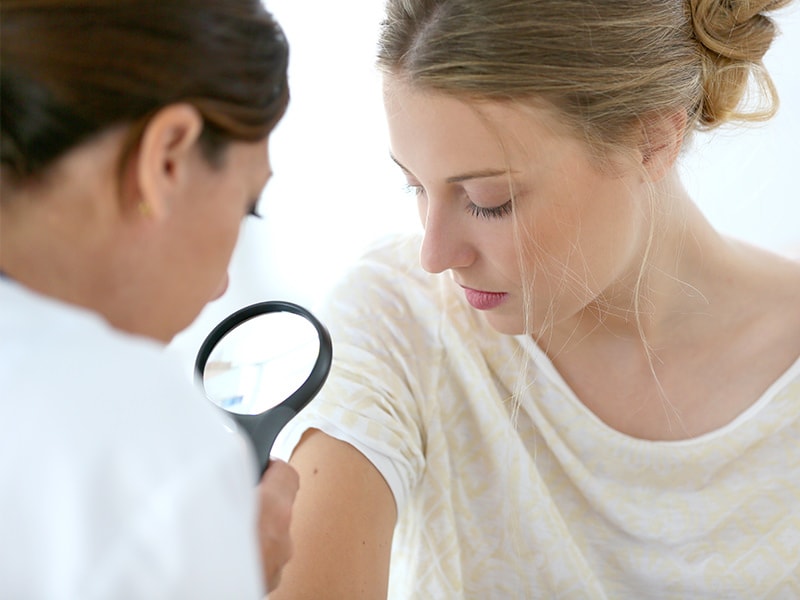In case of noticing disturbing and long-lasting skin lesions it is necessary to consult a dermatologist. Skin cancer is formed slowly and is preceded by skin lesions that are not neoplastic.Over the course Early detection of skin lesions or cancer gives a good chance of a full cure.
Basal cell carcinoma, or basal cell carcinoma.
It is a malignant tumour that originates from the non-keratinizing cells of the epidermis layer. Skin lesions occur mainly on the exposed parts of the body (neck, head), but there are also cases of lesions in other areas of the body. The character of basal cell carcinoma is described as locally malignant.
This means that some of its forms develop and slowly destroy more and more of the skin and deeper structures of the body. Untreated skin lesions can infiltrate adjacent areas, such as bone and vascular elements. The disease is the most common skin cancer and every year it affects 100-800 people per 100,000 white people.
Scientists have noticed that Australia is experiencing increased morbidity because sunlight is one of the factors causing the disease. The disease occurs mainly in the elderly and with fair complexion. The main causes of the disease are intensive exposure to sunlight and skin damage (e.g. scars, skin under dentures).
Symptoms and types of basal cell carcinoma
In 80% of cases, skin lesions are located on the scalp and neck. A very characteristic image of skin lesions is a small nodule surrounded by a cylindrical edge. On the surface of the nodule there is a small, often non-healing wound covered with a scab. Experts say that there are several types of basal cell carcinoma:
Nodular: is the most common form of disease that usually occurs on the forehead or wings of the nose. It manifests itself as a translucent nodule with pearly or waxy edges. Vascular spiders are often present on the skin lesion and a depression or a small scabbed morning appears in the middle of the lesion.
Infiltrating: skin lesions take the form of an ulceration that is not painful. It can infiltrate and destroy surrounding tissues, muscles and bones. The borderline of skin lesions is blurred and usually occurs around the corner of the eye, ears or nasolabial fold.
Surface: The skin lesion is a clearly delineated erythematous spot. It is often scabbed and located on the back or parietal part of the head.
Scleroderma-like: the lesion is less visible because it takes the form of an atrophic scar of skin colour. There are small cracked capillaries on it. This type of cancer usually occurs on the cheeks, forehead or around the nose.
Cystic: it resembles a soft, transparent lump in the eye area.
Mixed: different skin cancers occur within the same skin lesion. This type has an increased cancer aggressiveness.
Coloured: skin lesions are nodular or papular in blue-blue or black colour.

Diagnostics and treatment of basal cell carcinoma
Usually, just looking at the skin lesions gives the possibility to diagnose the disease and implement treatment. Some cases will require the use of a dermatoscope, which allows you to see the skin lesion at high magnification. Sometimes the specialist takes a slice of the skin lesion and then performs histopathological examinations.
The treatment consists in excision of the skin lesion with a small (1-2 mm) margin of healthy skin. An alternative method is radiotherapy and is used in patients who do not want to cut out the skin lesion. Radiotherapy is also used when the lesion is large in size or located in an inaccessible place.
Squamous cell carcinoma or squamous cell carcinoma
It is a malignant flat epithelial cancer that develops within the skin or mucous membranes. The characteristic location of the squamous cell tumor is the borderline between the mucous membranes and the skin. Frequent sites of skin lesions are the lower lip, tongue, orbital area, nose, and genitals.
The most common cause of the disease is solar keratosis, which develops in areas of the skin intensively exposed to sunlight. Specialists emphasize that patients after the disease should avoid excessive sunbathing and use sunscreen creams.
Symptoms of squamous cell carcinoma
The disease can take different forms from smooth to very keratinized platelets, nodules or ulcers. Skin lesions are often characterized by infiltration of the base and gelatinous raised edges. The skin is very susceptible to irritation and is often accompanied by itching. Specialists distinguish two types of this disease:
Ulcerative variety: skin lesions include deep ulcerations surrounded by a hard and raised edge.
Warts: these are nodules with uneven and papillary surfaces.
Symptoms of squamous cell carcinoma
The disease can take different forms from smooth to very keratinized platelets, nodules or ulcers. Skin lesions are often characterized by infiltration of the base and gelatinous raised edges. The skin is very susceptible to irritation and is often accompanied by itching. Specialists distinguish two types of this disease:
Ulcerative variety: skin lesions include deep ulcerations surrounded by a hard and raised edge.
Warts: these are nodules with uneven and papillary surfaces.
Diagnosis and treatment of squamous cell carcinoma
The doctor will certainly examine the skin lesions… and interview the patient. In order to make a diagnosis, doctors sometimes order other tests: Abdominal ultrasound, neck ultrasound, chest X-ray, histopathological examination, chest computed tomography.
Treatment usually involves surgery to remove the lesion and the surrounding healthy tissue. Radiotherapy is also performed, but only in patients who cannot undergo surgery to remove skin lesions. Some patients require a skin graft after the entire lesion has been removed. If the biopsy shows lymph node cancer, it should be removed.
Treatment of squamous cell carcinoma is characterized by quite good prognosis. Of course, we are talking about a quickly detected and not very advanced disease. Of course, we are talking about a quickly detected and not very advance disease Of course, we are talking about a quickly detected and not very advance disease. The disease develops quite slowly, but has the ability to destroy surrounding tissues and organs.
Prevention of the disease means, first of all, avoiding excessive exposure to the sun and the use of creams with filters. In case of disturbing skin lesions it is recommended to visit a dermatologist.




